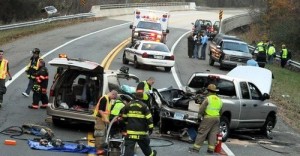Adults are just as likely as teens to have texted while driving and are substantially more likely to have talked on the phone while driving. These findings come from a new survey by the Pew Research Center’s Internet & American Life Project.
The Pew survey also found that 49% of adults say they have been passengers in a car when the driver was sending or reading text messages on their cell phone. Overall, 44% of adults say they have been passengers of drivers who used the cell phone in a way that put themselves or others in danger.
Beyond driving, some pedestrians using cell phones get so distracted while talking or texting that they have physically bumped into another person or an object. It is unknown how many have stepped in front of a vehicle from distracted walking.
Studies at Virginia Tech and elsewhere show that drivers using phones are four times as likely to cause a crash as other drivers are, roughly the equivalent of drunk driving. Almost 6,000 people were killed last year from distracted driving in automobiles, according to the National Highway Traffic Safety Administration. The U.S. safety agency also estimates that 515,000 people were injured in police-reported crashes in which at least one form of driver distraction was involved in the accident.
The problem appears to be worsening as automakers continue to add electronic devices to automobiles that enable new forms driver distraction, either by encouraging looking down to the instrument panel, or causing cognitive engagement that distracts from operating the vehicle.
As a result, seven states and the District of Columbia now ban all handheld cell use while
driving, 28 states ban all cell use by novice drivers, 18 states ban all cell use for bus
drivers, and 28 states ban texting while driving. NHTSA does not have the authority to impose national regulations.
The Distracted Driving Prevention Act, introduced last fall by Sen. Jay Rockefeller (D-WV), would provide incentive grants to states that ban texting and handheld cell phone use for all drivers and would require a complete ban on cell phone use by drivers under the age of 18. But it is all cell phone use that is at the center of the problem.
Here are some of the key Pew findings:
- Nearly half (47%) of all texting adults say they have sent or read a text message while driving. That compares to one in three (34%) texting teens ages 16-17 who said they had “texted while driving” in a September 2009 survey.
- Looking at the general population, this means that 27% of all American adults say they have sent or read text messages while driving. That compares to 26% of all American teens ages 16-17 who reported texting at the wheel in 2009.
- Three in four (75%) cell-owning adults say they have talked on a cell phone while driving. Half (52%) of cell-owning teens ages 16-17 reported talking on a cell phone while driving in the 2009 survey.
- Among all adults, that translates into 61% who have talked on a cell phone while driving. That compares to 43% of all American teens ages 16-17 who said they had talked on their phones while driving in the 2009 survey.
- Half (49%) of all adults say they have been in a car when the driver was sending or reading text messages on their cell phone. The same number (48%) of all teens ages 12-17 said they had been in a car “when the driver was texting.”
- Forty four percent of all adults say they have been in a car when the driver used the cell phone in a way that put themselves or others in danger. About the same number of teens (40%) said they had been in a car when the driver used a cell phone in a dangerous way.
- Beyond driving, one in six (17%) cell-owning adults say they have physically bumped into another person or an object because they were distracted by talking or texting on their phone. That amounts to 14% of all American adults who have been so engrossed in talking, texting or otherwise using their cell phones that they bumped into something or someone.
These new findings for those ages 18 and older come from a nationwide phone survey of 2,252 American adults (744 of the interviews were conducted on cell phones) conducted between April 29 and May 30. In that survey, 1,917 were cell owners and 1,189 used text messaging. The margin of error in the full sample is two percentage points and in the cell subpopulation is three percentage points.
The findings for teens are based on previously released data from a separate nationwide telephone survey conducted by Princeton Survey Research International between June 26 and September 24, 2009, among a sample of 800 teens ages 12-17 and a parent or guardian.


The cell phone and texting has unlocked the chain that tied business folks to their desk.
Yes, but not in a car please… – editor